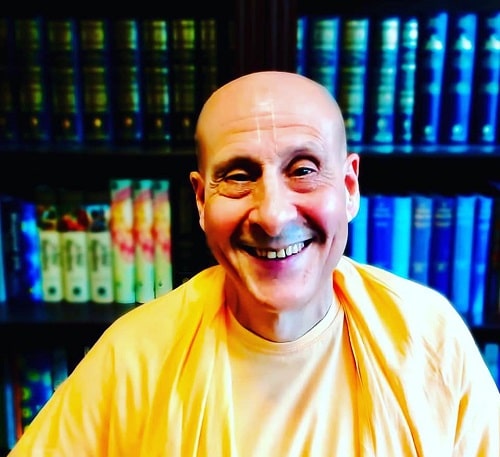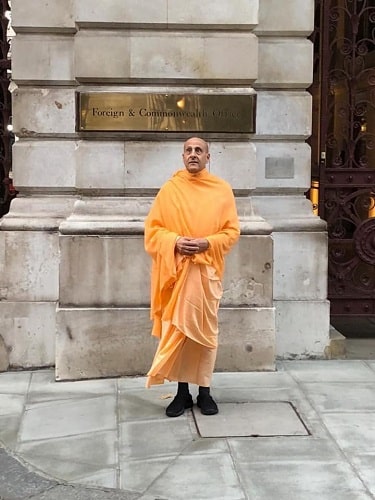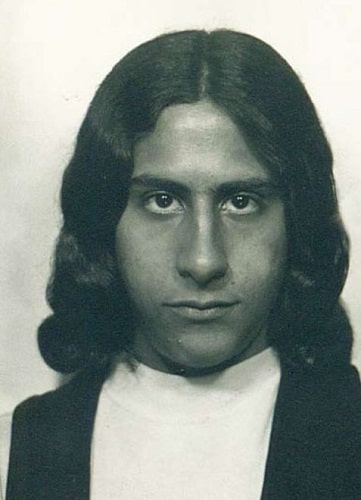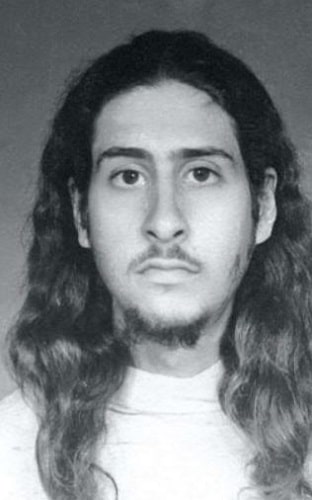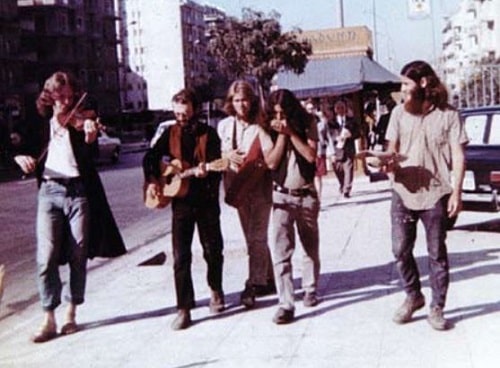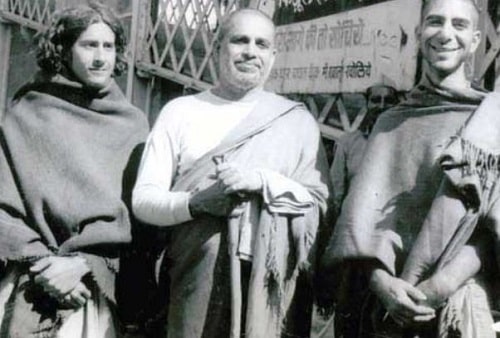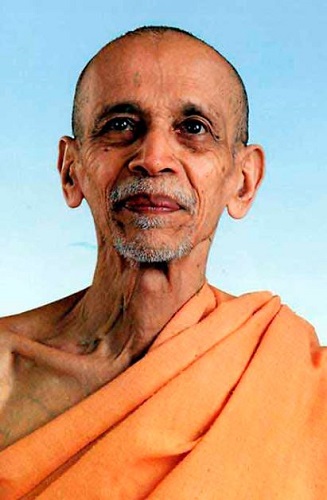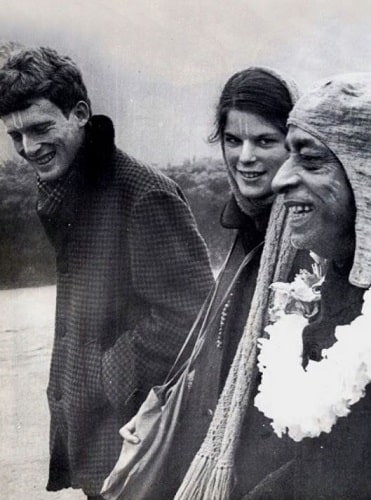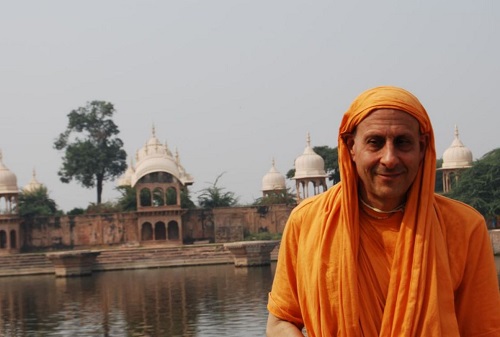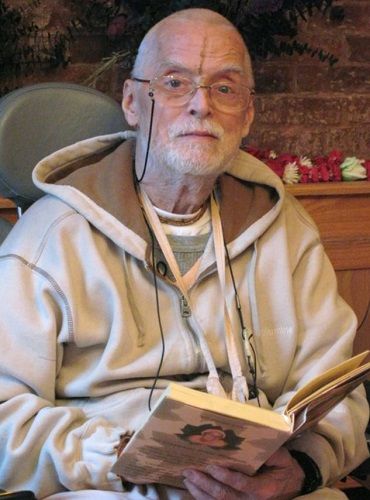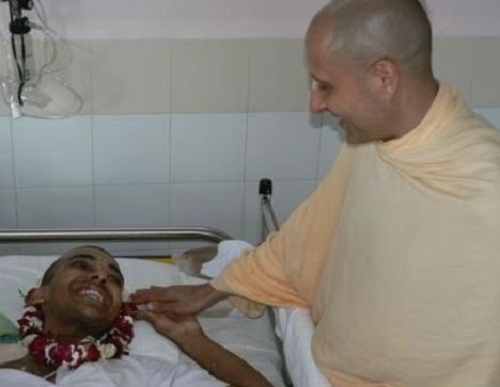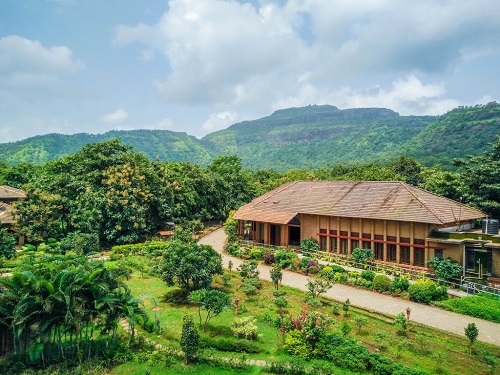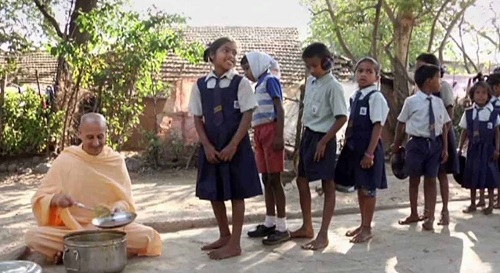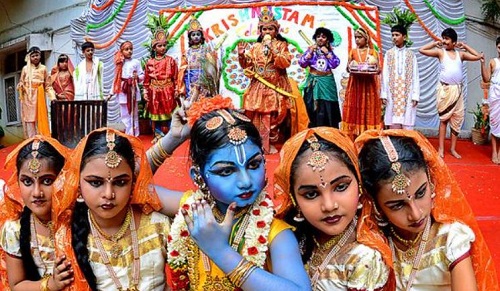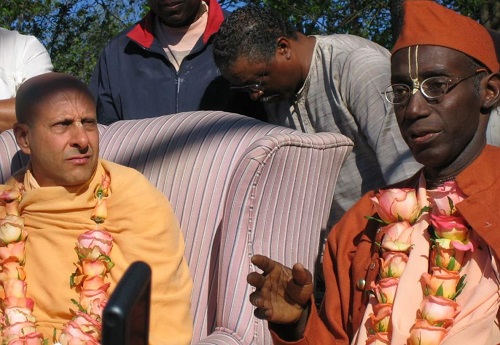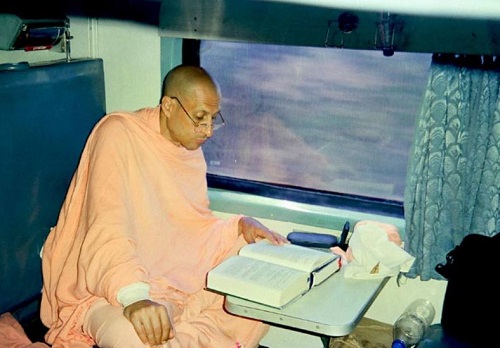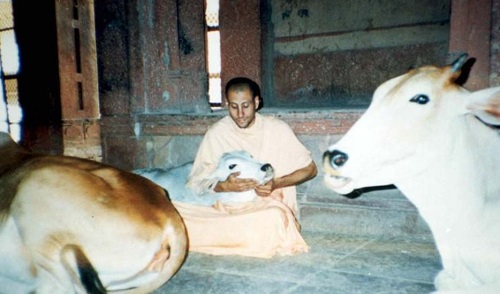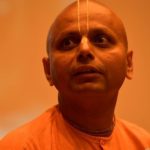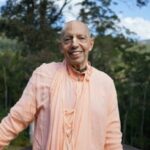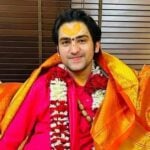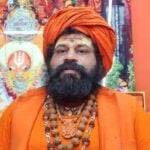Radhanath Swami Age, Wife, Family, Biography & More
Quick Info→
Hometown: Chicago, Illinois, United States
Marital Status: Unmarried
Age: 72 Years
| Bio/Wiki | |
|---|---|
| Real name | Richard Slavin [1]The Sacred Connect |
| Nickname | Richie [2]The Sacred Connect |
| Profession(s) | Spiritual Guru, Community Builder, Social Activist, Author |
| Physical Stats & More | |
| Height (approx.) | in centimeters- 173 cm in meters- 1.73 m in feet & inches- 5’ 8” |
| Eye Colour | Brown |
| Hair Colour | Bald (earlier black) |
| Career | |
| Awards | • 2011: Radhanath Swami receives the DY Patil Award for the ISKCON Food Relief Foundation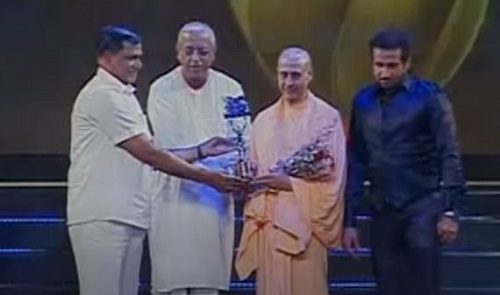 • 2012: GCL Award Giving Lecture Radhanath Swami ISKCON Chowpatty • 2017: Global Award for Excellence in Innovation at the UNWTO Awards for Govardhan Eco-Village |
| Personal Life | |
| Date of Birth | 7 December 1950 (Thursday) |
| Age (as of 2022) | 72 Years |
| Birthplace | Chicago, Illinois, United States |
| Zodiac sign | Sagittarius |
| Autograph | 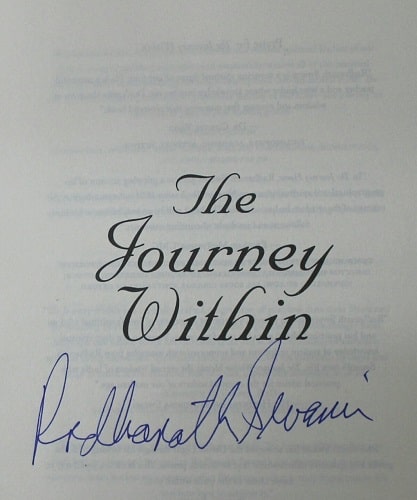 |
| Nationality | Indian |
| Hometown | Chicago, Illinois, United States |
| School | Deerfield High School, Chicago, Illinois, United States |
| College/University | Miami Dade College, Florida |
| Educational Qualification | Graduation in Psychology and Humanities (dropped out) [3]The Sacred Connect |
| Religion/Religious Views | After he became a Sannyasi (a renunciant), he chose to follow the Sanātana-dharma of the Gaudiya Vaishnavism sect. He believes in the teachings of Achintya Bheda Abheda and practices bhakti marg, which is a path of devotion. He also converted from Christianity to Hinduism. |
| Descent | Ashkenazi Jewish |
| Controversy | Alleged to be Involved in a Murder Case According to a website, he was involved in the death of Sulocahn, a member of ISKCON. [4]ISKCON Truth |
| Relationships & More | |
| Marital Status | Unmarried |
| Family | |
| Wife/Spouse | N/A Note: He follows celibacy. |
| Parents | Father- Jerry Gerald Slavin (auto repair shop) Mother- Idelle 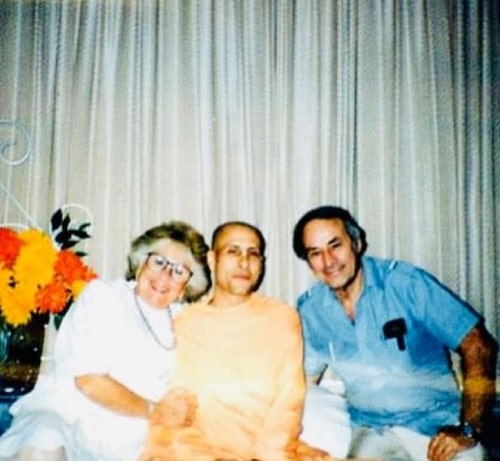 |
| Siblings | Brother(s)- Marty Slavin and Larry Slavin (elder) Sister- None |
Some Lesser Known Facts About Radhanath Swami
- Radhanath Swami is an American spiritual guru, community-builder, social activist, and author. He follows the Gaudiya Vaishnava tradition.
- During his teenage years, he used to take up jobs during his school vacations. While studying in school, he had a strong passion for wrestling and even won various competitions. However, in one match, he dislocated his shoulder, and he quit wrestling.
- As a child, Radhanath Swami displayed behaviours that he believed were connected to his past lives. Unlike most Americans, he didn’t like eating at a table and preferred sitting on the floor, as is customary in India. Although his parents didn’t allow him to do so, he started eating at the table while standing. He also had a strong aversion to meat and eggs, and just looking at them would make him feel sick. It took him several years to get used to eating meat without feeling nauseated.
- From a young age, he realized that a materialistic lifestyle would never bring him true satisfaction, and he was drawn to poverty and simplicity. He used to wash his new clothes multiple times until they appeared old before wearing them. He would also scrape his new shoes with rocks to make them look worn out. He admired those who were less fortunate, and having nicer things than others made him feel uncomfortable. Once, during a dinner at a country club, he disrupted everything and ran away from the table when he discovered that the busboy serving him was his classmate. Despite coming from a well-to-do family, he chose to work at the age of 15 to support his family financially. When Radhanath Swami was 19 years old and attending Miami Dade College in Florida, he had a strong passion for adventure.
- However, he soon discovered a strong inner longing for spirituality and a desire to explore deeper realities. He started chanting the sacred syllable “Om” with respect and learned meditation techniques from Maharshi Mahesh Yogi. Along with his friends, he became disillusioned with the materialistic ambitions prevalent in society during the 1960s and yearned for a greater purpose in life.
- During this time, he also realized that harbouring hatred towards those who hated him only perpetuated negativity. In support of Dr. Martin Luther King Jr.’s vision, he participated in a civil rights march. It was a unique experience for him as a white boy to be part of an Afro-American march. However, the meeting took a turn for the worse when the speaker used him as a symbol of everything they despised, hurling insults, and encouraging hatred and revenge. He managed to escape in time, and later, he said,
If a person does not have an idea he’s ready to die for, he has nothing really meaningful to live for.”
- Although his parents were not very religious, Radhanath Swami developed an interest in spirituality at a young age. When he turned 13, he had a bar mitzvah ceremony and learned to pray from a local rabbi. On his 13th birthday, his older brother Marty gave him the debut album of the folk-singing trio Peter, Paul, and Mary, whose songs against war and social injustice deeply impressed him, especially their songs about God.
- He became dissatisfied with the treatment of African Americans and opposed the Vietnam War, embracing the ideals of Martin Luther King Jr. After a close friend died in a car accident, he started pondering the meaning of life. Influenced by his peers, he immersed himself in the hippie counterculture, growing his hair long and smoking. In the summer of 1968, his adventurous spirit led him to hitchhike to California, where he spent nights on the beaches and visited the famous Haight-Ashbury district in San Francisco, a gathering place for hippies.
- Feeling disillusioned by the materialistic values he witnessed in America, Radhanath focused on his college studies and began exploring Eastern spirituality through reading books and practising meditation. While immediate satisfaction eluded him, he recognized the importance of finding a genuine spiritual guide. In the summer of 1970, after completing his first year of college, Radhanath attended a rock festival on Randalls Island, where he encountered the Hare Krishnas, a Hindu religious organization.
- The Hare Krishnas gave him a pamphlet featuring photos of the Indian spiritual leader A. C. Bhaktivedanta Swami Prabhupada. Inspired by this, Radhanath, along with his friends Frank and Gary, made the decision to travel to Europe. This decision was significant because nobody in his family had ever ventured beyond America. Despite his parents’ shock and desperate pleas for him to stay, he remained determined to embark on this journey, even after his father expressed concerns for his safety and emphasized the dangers of the world, which mirrored the descriptions found in Indian religious scriptures.
- During his time in Europe, Radhanath encountered diverse customs and cultures, which fascinated him coming from the American Midwest. This exposure to different cultures expanded his perspective. He also enjoyed reading books about Eastern spirituality and the Bible, which he had brought with him from America.
- Radhanath Swami had a deep fascination with visiting churches and monasteries and always took the opportunity to speak with priests and monks. In Rome, he engaged in long conversations with Franciscan friars, discussing Jesus and the connection between Christianity and Judaism. He and his friend Gary were fortunate enough to attend a speech by the Pope at the Vatican. During their travels, they had a profound experience observing Catholic monks meditating in the catacombs of a monastery, surrounded by the remains of their predecessors. One of the monks spoke about the fragility of physical bodies.
- At a certain point, Radhanath and Gary temporarily separated, and Radhanath embarked on a pilgrimage to Assisi, a place associated with the renowned Catholic saint, Francis of Assisi. This pilgrimage prompted him to reflect on how his upbringing shaped his perception of reality in a narrow-minded manner. He desired that his quest for spiritual understanding would help him develop an appreciation for diverse cultures and the people who embrace them. It was his open-mindedness that allowed the initial spark of spiritual yearning, ignited during his travels, to evolve into an intense longing to truly know God.
- While Radhanath was in Athens, he and Gary decided to make money. They began by donating blood, and then they teamed up with a Swiss violinist and a French guitarist to play music and collect money on the streets. However, the police intervened and confiscated the money they had earned. This made Radhanath and Gary feel downhearted. They decided to go to Crete, where Radhanath discovered a cave near the sea to live in. At this point, Radhanath had lost interest in the free-spirited lifestyle and beliefs of the hippies. His attention shifted more towards spirituality.
- One morning, while Radhanath was deep in meditation and prayer on top of a rock, he heard a voice inside him urging him to travel to India. Surprisingly, on the same morning, Gary also felt a strong inner voice guiding him to go to Israel. After saying goodbye to Gary, Radhanath embarked on his journey without any money or concrete plans. However, he firmly believed that by hitchhiking towards the east, he would eventually arrive in the country that held the answers to his prayers. In Athens, Radhanath met two other hippies who were also heading east, so he decided to join them on a popular hippie route to India. Their journey took them through Turkey, Iran, Afghanistan, and Pakistan.
- In Turkey, they faced significant challenges because of a cholera outbreak. They narrowly escaped from bandits in Istanbul and continued their journey by bus through Ankara to reach the Iranian border. When they arrived in Tehran, it was during the holy month of Ramadan. Since Radhanath had developed an interest in Islam, he decided to part ways with his friends and spent a few days in Mashhad, an important place of pilgrimage for Shia Muslims. It was there, at the mausoleum of Imam Reza, that he met a Muslim who spoke English and taught him the basics of Islam and the customs followed by Muslims.
- After arriving in Afghanistan, Radhanath stayed in Herat for a few days, where a poor family kindly offered him shelter. This was the first time he experienced a culture shock because, despite their poverty, the Afghan people seemed content. In Kandahar, he came across a blind boy who would spend hours singing songs about God’s love on the streets. This boy left a lasting impression on Radhanath as he appeared to be the happiest person he had ever encountered. It made Radhanath contemplate deeply on the nature of happiness. Additionally, Radhanath had a significant and life-changing encounter with drugs in Kandahar, which led him to make a vow never to use drugs again.
- In Kabul, a young woman from the Netherlands tried to entice him and pressure him into engaging in sexual activities. However, Radhanath recognized that such actions were not aligned with his spiritual quest. He firmly rejected her advances and made a promise to himself to remain celibate.
- After a challenging journey to reach India, Radhanath encountered difficulties at the Indian immigration office. It took him six months of hitchhiking across Europe and the Middle East before finally arriving in India. When he arrived at the immigration office, Radhanath approached a Sikh officer with humility, pleading for permission to enter the spiritual land of India. He tearfully shared his story, explaining that he had left behind the comforts of America to seek India’s spiritual treasures, risking his life along the way. Radhanath promised that one day he would do something good for the people of India. Touched by his sincerity, the Sikh officer granted him permission and stamped his legal entry into the country. As Radhanath stepped foot into India, everything seemed both excitingly new and strangely familiar to him.
- On his first day, he witnessed a bustling railway station where people were cooking, begging, and sleeping amidst the chaotic noise. In a bold move, he jumped onto a moving train in a crowded compartment meant for sixty people but packed with two hundred. While in this state, he was offered bhang, a drink made from cannabis, which had a hypnotic effect on him.
- In this altered state, a snake charmer approached Radhanath and demanded fifty rupees to place a deadly snake around his chest. During his travels in India, Radhanath also encountered a yogi who sought charity from pilgrims. When ignored, the yogi became angry and performed seemingly miraculous acts to gain attention. He took out a live bulb, crushed it into powder, and consumed it with water from the Ganges. He then balanced a steel rod on his cloth-covered eye socket and walked towards a wall, with the rod bending more and more with each step. Finally, he reached the wall, discarded the bent rod, and revealed his undamaged eye. Pilgrims were astonished and donated money to him. However, the yogi later confessed that his guru had taught him these powers but had rejected him upon discovering that he was using them for personal gain. After witnessing all of this, Radhanath felt disappointed and realized that mystical powers are not necessarily spiritual.
- When Radhanath was in Patna, he met a holy man named Narayan Prasad and his teacher, Rama Sevaka Swami, who used to chant the holy names of Lord Rama for a long time and personally fed Radhanath with his own hands. One day, a monk cooked a dish called khichari for everyone which was extremely spicy and caused Radhanath a lot of pain while others enjoyed it. Despite Radhanath’s attempts to refuse more servings, the cook insisted on giving him more. Radhanath didn’t want to hurt the cook’s feelings, so he didn’t say anything. The cook thought Radhanath was crying tears of gratitude. Radhanath learned that it’s not always easy to make others happy, but enduring the pain was worth it because it pleased the holy person.
- In Kurukshetra, Radhanath studied the Bhagavad Gita while sitting under the same banyan tree where Krishna originally had a conversation with Arjuna. He found great comfort and guidance in the immortal words of Lord Krishna. In a world full of dangers, temptations, and fears, Radhanath discovered that the Gita became his practical guide, giving him direction and comfort.
- While Radhanath was in India, he saw cows freely wandering the streets of Delhi. This experience made him develop a dislike for meat, and he became a vegetarian. In Delhi, he took part in the “World Conference of Yoga,” which brought together more than 800 spiritual teachers, yogis, sages, and scholars. During the conference, Radhanath had the chance to meet Swami Rama, the founder of the Himalayan Institute. When Radhanath asked for his blessings, Swami Rama advised him that his spiritual progress would depend on his connection with saintly individuals who would help him overcome obstacles on his spiritual journey.
- During the conference, Radhanath had the opportunity to meet Swami Satchidananda, who was a famous student of Swami Sivananda. Swami Satchidananda explained the true meaning of yoga to Radhanath. He taught him to focus on the good qualities of others instead of their flaws. Swami Satchidananda blessed Radhanath, hoping that he would discover the treasure within his own heart. Radhanath attended lectures by Jiddu Krishnamurti, a wise Indian guru and philosopher known for his ability to answer any question and challenge arguments. Krishnamurti taught Radhanath that spiritual life should not be superficial. People often become attached to external things and rituals, forgetting that the main purpose of spiritual practice is to purify one’s heart. The conference’s last day took place in Vigyan Bhavana in New Delhi, with more than 3,000 attendees. However, the gurus at the event competed for the microphone, each trying to convince the audience that their path was the best.
- In January 1971, Radhanath journeyed to the Himalayas in search of a guru. He arrived in Rishikesh and stayed at the “Divine Life Society,” an ashram founded by Swami Sivananda. There, he had lengthy conversations with Swami Chidananda, a student of Swami Sivananda who took over the ashram after his guru passed away. Swami Chidananda encouraged Radhanath to practice japa meditation, which involves chanting mantras on a rosary.
- In the 1980s, Radhanath Swami shared in an interview with Larry D. Shinn about his spiritual practices in India. He found a peaceful spot on the banks of the Ganges where he would chant “Hare Krishna” and other mantras for many hours each day. It was during this time that he met a holy person who asked him to throw away all his Western clothes into the Ganges. In return, the holy person gave him a simple garment worn by Hindu ascetics. Radhanath started practising strict self-discipline, meditating on a rock in the middle of the Ganges from sunrise to sunset for a whole month. He sustained himself with a diet of raw vegetables, fruits, and nuts. Later, he met another holy person who taught him new meditation techniques.
- Despite his efforts, Radhanath couldn’t find a guru in the Himalayas, so he continued travelling throughout India. He stayed with Advaitins in Varanasi for a while and also spent time with Buddhist monks in Bodh Gaya, the place where Buddha attained enlightenment.
- When Radhanath arrived in Bombay (now Mumbai), he saw a poster announcing festivals organized by American Hare Krishna devotees and their spiritual leader, A. C. Bhaktivedanta Swami Prabhupada. Out of curiosity, he attended a Hare Krishna program that evening and heard Prabhupada speak for the first time. Prabhupada’s lectures had a strong impact on Radhanath. The Hare Krishnas passionately shared their beliefs with their fellow hippie countrymen, but Radhanath wasn’t yet ready to fully embrace their teachings. He believed that all paths led to God and didn’t understand why it was necessary to specifically follow Prabhupada and his followers.
- After leaving the Hare Krishna group, Radhanath continued his journey, going from one spiritual community to another and searching for different teachers. A few months later, he was in Mathura when they were celebrating Krishna Janmashtami, a special festival dedicated to Lord Krishna.
- Radhanath stayed at an ashram in Vrindavan, where a well-known Hare Krishna guru named Swami Bon lived. Swami Bon, who was like a brother to Prabhupada, warmly gave him the name Ratheen Krishna Das. At this point, Radhanath looked like a genuine Indian hermit with a thin body due to poor eating and long, tangled hair called dreadlocks on his head. However, people at the ashram didn’t like his long and messy hair.
- Bon Maharaj asked Radhanath to shave his head like everyone else at the ashram. He explained that shaving his head was a way of showing surrender and respect to a mentor, but Radhanath didn’t feel ready for that yet. Maharaj suggested that at least he cut his hair shorter since it was halfway down his waist and very tangled. Radhanath agreed, but his hair was so thick that normal scissors couldn’t cut through it. They called a gardener who had special loppers used for cutting bushes. The gardener, along with a barber and their helpers, struggled to cut Radhanath’s hair with the loppers.
- Finally, after a lot of effort, the blades of the loppers came together, and the haircut was completed. Asim, a friend Radhanath made in Vrindavan, found the situation so funny that he laughed until tears streamed down his face. Later, in Vrindavan, Radhanath visited the tomb of a famous saint named Rupa Goswami.
- While kneeling in front of the tomb and silently praying, strong energy filled Radhanath’s body and mind. It was at that moment that he realized the path of devotion, called Bhakti-yoga, was the right path for him. All his previous doubts and hesitations vanished, and he knew that by following this path, he would discover the love of Krishna. However, he still felt a sense of emptiness because he knew he needed to find a guru to whom he could fully commit himself.
- During his prayers, he fervently asked for guidance and direction. Later, Prabhupada came to Vrindavan with a group of American students. While listening to Prabhupada’s lecture, Radhanath became convinced that the Gaudiya Vaishnava philosophy was perfect and that Prabhupada truly loved God.
- Watching Prabhupada sing Bengali bhajans with profound religious devotion left a lasting impression on Radhanath. He believed that Prabhupada was the greatest guru and saint he had met throughout his travels in India.
- Prabhupada patiently answered all of Radhanath’s questions and supported each answer with scriptural quotations. Radhanath also noticed that Prabhupada’s actions were in line with his teachings. However, at that time, Radhanath chose not to join the Krishna consciousness movement and decided to stay in Vrindavan even after Prabhupada and his disciples had left.
- While staying with a saint named Ramesh Baba in the mountains of Varsana, Radhanath discovered the significance of having unwavering faith in God. One day, a young boy pointed to a painting of Krishna and expressed, with pure innocence and faith, that Krishna was his God. This incident reminded Radhanath of the teachings of Lord Jesus, who said that only those who possess the purity and faith of a child can enter the kingdom of God. Inspired by this, Radhanath prayed to attain such steadfast faith.
- Despite facing constant threats from dangerous individuals armed with guns and knives, Ramesh Baba remained fearless because he found solace in chanting God’s names through kirtan. He firmly believed that as long as Krishna was pleased with him, the actions of these thugs were insignificant.
- Radhanath witnessed Ramesh Baba’s incredible faith when he saw him sleeping with a small stick beside him for protection against a leopard. When Radhanath questioned the effectiveness of the stick, Ramesh Baba explained that true protection comes only from the Lord. However, he carried the stick as a symbolic gesture to demonstrate his willingness to do his part. Ramesh Baba taught that chanting the holy names of God serves as our ultimate shield, and one should cultivate unwavering faith in these divine names.
- When Radhanath was in Varsana, he learnt how important it was to have faith in the holy names. Once, while he was in the fields, a dangerous snake came near him while he was crouching down. He felt really scared, but he quietly chanted the Hare Krishna Maha Mantra. As he kept chanting, he started to feel peaceful, and his fear went away. The snake went away into the bushes, and Radhanath understood that he was like a little child on his spiritual journey. Just like a child seeks protection from their parents, he found safety in the holy names of God. Through his adventures, Radhanath learned important lessons about the power of faith.
- He realized that when everything seems to be going wrong in life, faith alone can help us see God’s guiding hand and believe that everything will be okay. He said that true happiness doesn’t depend on how much money we have but on our faith in God. He compared faith to a tree that takes a long time to grow but can be destroyed quickly.
- While he was in Vrindavan, Radhanath had the chance to meet Srila Prabhupada, also known as A. C. Bhaktivedanta Swami Prabhupada, the Founder-Acharya of ISKCON, who was visiting with his followers from the western countries. However, some of Srila Prabhupada’s top followers would sometimes scold Radhanath and try to pressure him into joining their movement and travelling with them.
- Even though Radhanath was used to such pressure, he didn’t like it. He believed that surrendering to a guru should come from a deep sense of faith and inspiration, not because of external pressure.
- One day, Srila Prabhupada asked Radhanath how long he had been staying in Vrindavan. Radhanath expected Srila Prabhupada to criticize him for staying there for such a long time. He replied, “About six months, Srila Prabhupada.” After a moment of silence and looking directly into Radhanath’s eyes, Srila Prabhupada affectionately rubbed his head and said, “Very good, Vrindavan is such a wonderful place.” In this short conversation, Radhanath felt the love of an eternal friend, a caring parent, and God. It had a deep impact on him that he couldn’t fully understand or explain. Radhanath closed his eyes and thought about why Srila Prabhupada, who had countless people waiting for his attention all over the world, took the time for him. Radhanath saw himself as a poor being who slept under a tree. He wondered if perhaps the miracle of being an instrument of kindness was the most powerful thing of all. Later, Radhanath made the decision to fully surrender to Srila Prabhupada and accept him as his guru.
- In 1972, Radhanath had to return to America because the Indian government didn’t extend his visa. He stayed in Krishna temples in Amsterdam and London before reuniting with his parents in Miami. Later, he went to New York and met Prabhupada, the founder of ISKCON. Prabhupada asked him to stay in America and help develop the New Vrindaban community in West Virginia, under the guidance of Kirtanananda Swami. Radhanath followed Prabhupada’s advice and settled in New Vrindaban. He took care of cows and spent his free time reading Prabhupada’s books. He received initiation from Prabhupada in the United States in February 1973 and was given the name ‘Radhanath Das.’
- On 11 February 1973, Radhanath accepted Prabhupada as his guru after being convinced by the philosophy and examples of the people in the community. He stayed in New Vrindaban for the next six years, contributing to its growth, even though life there was simple and lacked heaters and hot water during the cold winters. Radhanath practised Hare Krishna’s spiritual traditions, took care of cows, and served the temple deities. On 1 August 1976, he received Brahminic initiation from Prabhupada.
- During the early 1980s, Radhanath gave talks at universities in Ohio and Pennsylvania and also taught classes on vegetarian cooking. In 1982, Kirtanananda Swami offered him the opportunity to become a sannyasi, which means a person who renounces worldly attachments.
- The ceremony for sannyasa initiation happened in May 1982 in New Vrindaban, where Radhanath received the title of “swami” and became Radhanath Swami. Initially, Radhanath was uncertain about accepting this honour and the respect that came with it, as he believed it might hinder his spiritual progress. However, after some persuasion, he eventually agreed. In 1983, he embarked on a pilgrimage to India and reunited with old friends.
- In 1987, Radhanath Swami, along with Kirtanananda Swami and other followers, were expelled from ISKCON because they had deviated from the organization’s principles.
- In 1988, Radhanath Swami went to India and took on a project in Mumbai. He established the Radha Gopinath Temple, an ashram, and a spiritual community. The area where Radhanath Swami lived during the late 1980s was impoverished. The neighbourhood was noisy, and he had to share his living space with large rats that even scared away cats. Even by Indian standards, the place was extremely dirty and unpleasant. However, Radhanath Swami lived there happily, chanting the names of God and inspiring others with his exceptional qualities of tolerance and patience.
- He was fully dedicated to selfless service, which helped him rise above the limitations of his physical surroundings. In the 1990s, Kirtanananda encountered legal problems and was sentenced to prison for mail fraud. In 1994, Radhanath Swami returned to ISKCON and took on leadership roles, serving on the Governing Body Commission and becoming an initiating guru.
- From 1995 to 2010, Radhanath Swami led ISKCON in different locations including Maharashtra, Goa, Daman and Diu, West Virginia, Ohio, Kentucky, Italy, and Belgaum.
- When one of Radhanath Swami’s young students, Stoka Krishna, was fighting cancer and approaching the end of his life, Radhanath Swami supported him with spiritual guidance. He constantly reminded Stoka Krishna of the kindness of God and encouraged him to focus on remembering God and finding hope in him instead of relying on material comforts. Radhanath Swami vividly described the spiritual world to Stoka Krishna, giving him a glimpse of the eternal realm beyond our temporary existence. Even in challenging circumstances, Stoka Krishna smiled and expressed gratitude to God and the devotees. His passing not only showed his bravery in facing death but also gave hope to Radhanath Swami’s followers, reminding them of the unlimited mercy of the divine.
- A group of dedicated people, led by Radhanath Swami, started working on the Govardhan Ecovillage in 2003. Their main goal was to create a sustainable living model that showcased self-sufficiency, a localized economy, and living in harmony with nature. They achieved this by establishing various important aspects of the eco-village, such as organic farming, protecting cows, education, rural development, alternative energy, eco-friendly buildings, and sustainable living practices. The Govardhan Ecovillage is located near the Sahyadri mountain range, about two hours away from Mumbai, and it was officially opened on 24 December 2011.
- During the opening, the eco-village was introduced as a place for retreat and relaxation. It had environmentally friendly cottages, an auditorium, seminar and conference rooms, an Ayurvedic wellness centre, and a yoga centre. Radhanath Swami shared his vision and the purpose behind creating the Govardhan Ecovillage. He emphasized the principle of “simple living, high thinking” and the importance of living in harmony with Mother Earth, who is the mother to all life on the planet. He urged everyone to honour and take care of her because we depend on her.
- The Govardhan Ecovillage was designed to meet the needs of individuals and corporate groups while integrating spirituality with the demands of modern life. Its aim is to serve as a model, showing how spirituality and the needs of the modern world can go hand in hand. Radhanath Swami stressed the importance of giving back to Mother Earth and not just taking from her in our pursuit of technology. The buildings in the eco-village are constructed using natural materials like cob, rammed earth, and Compressed Stabilized Earth Blocks (CSEB).
- The Bhaktivedanta Hospital, connected to the Radha Gopinath Temple community, is a well-known place in Mumbai for taking care of people’s overall health and spiritual well-being. In 1991, five young medical graduates who became devotees of Lord Krishna while in medical school came up with the idea of providing holistic care with a Krishna-conscious approach to as many people as possible. They started by organizing medical camps in different parts of Maharashtra, reaching out to underprivileged individuals who didn’t have easy access to modern medical facilities. Eventually, they established the Bhaktivedanta Clinic, a small seven-bed facility on Mira Road, a suburb near Mumbai.
- As time went on, the clinic grew into a modern 210-bed hospital with a team of 1,000 devoted staff members. The hospital has six advanced operation theatres and a comprehensive heart centre where procedures like angiography, angioplasty, and open-heart surgeries are performed. Every year, the hospital serves around 250,000 outpatients and admits about 20,000 inpatients from both India and other countries. In addition, Bhaktivedanta Hospital has set up twelve satellite centres, mainly in Maharashtra. These include a hospice in Vrindavan, Lord Krishna’s birthplace, and an eye hospital in Varsana, Radharani’s birthplace. The hospital mainly practices modern medicine but also offers alternative therapies like homoeopathy, Ayurveda, naturopathy, yoga therapy, and acupuncture. Their approach to patient care is holistic, considering not only the physical body but also the mind and soul. Spiritual care is an essential part of the services provided at Bhaktivedanta Hospital.
- Radhanath Swami, with his guidance, started an orphanage called ‘ISKCON Chowpatty’ located on the outskirts of Mumbai. Currently, the orphanage provides care for fifty children, taking care of their physical, emotional, and spiritual well-being. A team of trained teachers, supervised by trustworthy individuals, ensures that all the children’s needs are taken care of. The children also perform plays in nearby villages to share spiritual knowledge and entertain thousands of villagers. In 2004, the Indian Government’s Midday Meal Scheme, which supports underprivileged children in public schools, approached ISKCON Chowpatty to be part of the program.
- Radhanath Swami’s inspiration led to the creation of the Annamrita school meal program. On its first day, the program served meals to 900 children. Over 15 years, Annamrita has made a significant impact on the lives of more than 1 million children in over 6,500 schools across India. The name “Annamrita” means “food as pure as nectar.” Poverty and hunger are widespread issues in India, with many people not having access to even one nutritious meal a day. This unfortunate situation is caused by a cycle of poverty and illiteracy that has affected the country for a long time. Annamrita aims to break this cycle by providing pure, plant-based meals to underprivileged children. These meals are strictly vegetarian and prepared in a technologically advanced and highly clean kitchen, creating a spiritual environment. It is believed that such pure food nourishes the mind, body, and soul of the children it serves.
- Gopal’s Fun School (GFS) is a weekend program designed for kids living in urban areas. It was created at ISKCON Chowpatty with inspiration from Radhanath Swami. GFS focuses on giving children a well-rounded education that helps shape their character and personality. They participate in interactive workshops that encourage them to develop important values and talents. Even simple acts like offering flowers to the altar teach them about giving and being compassionate to others. In this program, children of different ages receive expert training in spirituality. The goal is to help them understand God and become responsible, law-abiding citizens. As they progress, they learn to make wise decisions that align with the values caring parents want for their children.
- As part of the program, students explore different aspects of the Bhagavad Gita, play outdoor games inspired by Krishna Consciousness, join in kirtans (devotional chants) using musical instruments, and learn bhajans (traditional Indian folk music). Alongside these activities, they also develop a sense of responsibility towards themselves and society. GFS currently has around 350 students, ranging from ages 3 to 21, divided into different age groups. The school is growing, with two schools in Thane and a couple more in South Mumbai. Many parents express satisfaction and appreciation for the institution and the positive impact it has on their children’s lives.
- Gopal’s Garden High School was established in July 2001 under the guidance of Radhanath Swami. It started in a rented flat with 9 children and 6 staff members, and it has now grown to have over 175 students. The school has a dedicated team of trained teachers and staff members who are qualified professionals with extensive experience. It is well-equipped with important facilities like a library, a computer lab, a science lab, a sports room, a music room, and a counselling department. These resources contribute to offering a comprehensive education for the students.
- To nurture a spiritual atmosphere among the students, the school incorporates an aarti ceremony and a short Bhagavad Gita class into their daily schedule. These activities aim to instil spiritual values and teachings in the students. Overall, Gopal’s Garden High School aims to provide a caring and holistic learning environment for its students, combining academic education with spiritual growth.
- At Radha Gopinath Temple in Mumbai, Radhanath Swami initiated the Devotee Care Program, which later spread to ISKCON centres worldwide. This program is dedicated to assisting and supporting the devotees in the temple community.
- The Devotee Care Program offers a wide range of services at Radha Gopinath Temple. They provide cultural education and schooling for children, take care of orphans, engage with and share teachings with young people, assist with marriages, support monks and the elderly, offer counselling for married individuals, provide financial assistance, manage a hospital and a farm, organize yearly pilgrimages, drama festivals, and the ISKCON Food Relief Foundation.
- Under the guidance of Radhanath Swami, the Chowpatty Temple in Mumbai established the Devotee Care and Relations Program in 1986. This program is designed to address the physical, emotional, and spiritual needs of devotees. It resulted in the creation of the Bhaktivedanta Hospital, the ISKCON Food Relief Foundation, financial aid programs, and other initiatives focused on devotees’ well-being. To provide emotional and spiritual support, the temple developed Grihastha Counseling, where experienced devotees offer formal guidance to help new devotees grow spiritually.
- Moreover, the temple organizes trips to Govardhan Farm, a tropical fruit and bamboo nursery in the Caribbean. These trips offer recreational activities that also nurture the devotees’ spiritual journey. The success of the Devotee Care and Relations Program at Radha Gopinath Temple serves as an inspiration for similar initiatives worldwide. It sets a positive example for the development of similar programs in other ISKCON communities, including the one in New Vrindaban.
- Bhakti Tirtha Swami was a close friend of Radhanath Swami and played a big part in inspiring him to write the book ‘Journey Home.’ Bhakti Tirtha Swami’s life was a beautiful example of how God’s grace can be present.
- Even though Bhakti Tirtha Swami faced tough times, like battling cancer and going through amputations, especially in the later stages of his life, he accepted these challenges with grace and dignity. His actions showed others how to handle suffering in a graceful way. Radhanath Swami believes that heartfelt experiences like those of Bhakti Tirtha Swami help us understand the purpose and importance of going through difficult times.
- Upon the request of his terminally ill friend and godbrother Bhakti Tirtha Swami, Radhanath Swami reluctantly agreed to write about his personal journey and experiences in a memoir called “The Journey Home: Autobiography of an American Swami.” Initially hesitant, he decided to fulfill Bhakti Tirtha Swami’s wish and documented his life story in the book. Apart from that, Radhanath Swami has authored several spiritual books, including “The Journey Within: Exploring the Path of Bhakti,” which became a New York Times Bestseller in the category of ‘Religion, Spirituality, and Faith’ in July 2016. Some of his other works include “Nectar Drops and Nectar Stream,” “Evolve,” “Six Goswamis of Vrindavan,” “The Wisdom Tree,” and “The Real You.”
- Radhanath Swami’s influence extends globally, and he is highly recognized and respected for his humanitarian efforts. He has played a significant role in promoting the teachings of ISKCON and is regarded as an inspirational spiritual leader within the organization. His impact goes beyond ISKCON as well. He serves on the advisory panel of I-Foundation, which successfully launched the first government-funded Hindu faith school in London.
- Through his interfaith discussions with individuals like Cornel West and Francis X. Clooney, Radhanath Swami has fostered meaningful dialogues and understanding between followers of different beliefs. His discussion with Cornel West at Princeton University received the prestigious 2011 Santos-Dumont Prize for Innovation, recognizing its impact and visibility in promoting interfaith dialogues.
- Radhanath Swami has also shared his spiritual wisdom and insights in esteemed forums. He presented ancient spiritual solutions to modern challenges at the renowned Oxford Union debating society. Additionally, he was the main speaker at a corporate workshop organized by the Confederation of Indian Industry (CII), where he addressed over 150 top executives from India’s corporate sector.
- During a session called “Spirituality: Leadership and Management,” Radhanath Swami highlighted the values of integrity, humility, and simplicity when it comes to daily business matters.
- In his free time, he enjoys engaging in meditation, listening to music, singing bhajans (devotional songs), and reading spiritual books.
- Radhanath Swami has his own YouTube channel with approximately 434k subscribers.
On his channel, he uploads videos of his speeches.
- Radhanath Swami has been invited as a guest speaker to various events. He has given speeches about the Bhagavad Gita at different universities and events. He presents the Gita’s teachings as something that goes beyond historical and religious boundaries. According to Radhanath Swami, to truly benefit from studying the Bhagavad Gita, one must approach it with an open heart and a willingness to embrace Krishna’s message of love. He emphasizes the importance of being sincere and committed to one’s spiritual journey. His speeches are broadcasted on religious TV channels like Aastha.
- He has a deep affection for animals and has actively worked towards their welfare.
References/Sources:

